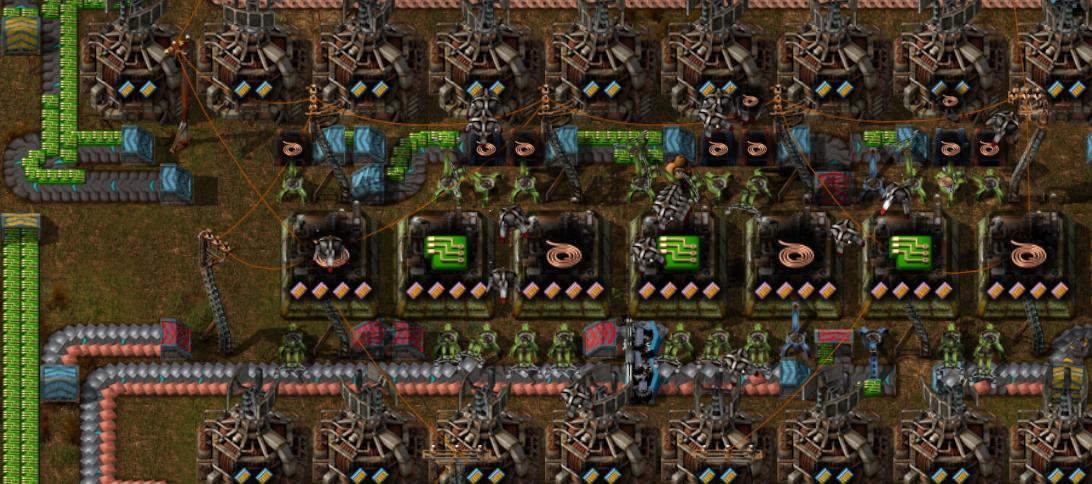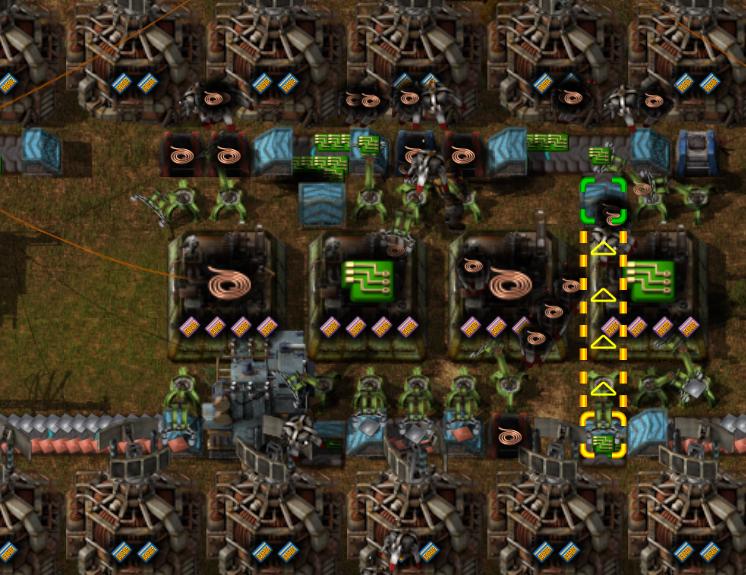Do Prod+Speed Beacon setups save energy?
Posted: Fri Jul 08, 2016 10:45 pm
The question of this topic is, can you save energy by using prod3/speed3 setups? You might think, What? You crazy? Isn't it an obvious exchange: You put absurd amounts of electricity in and get some free items out? Doesn't it obviously require more electricity? Except it's also really expensive in terms of energy to make items. In this analysis I'll be comparing with eff1 modules for the simple reason that using eff1 modules is actually in general a good and solid strategy, while using eff2 and eff3 modules is energetically a very unsound strategy because a watt generated by solar/accu is so much cheaper than a watt saved by eff2.
I'll be using an Assembler 3 doing the Electronic Circuits recipe. The assembler has 4 Prod3 Modules, and benefits from 8 Beacons, which all effect 8 assemblers, so it ends up with +400% speed from the beacons and pays a 1/8th share of the energy cost.
Assembler 3 doing Electric Circuits
The first energy number is no modules, the second number is with a full load of eff1 modules:
The final question is, how many assembler 3's does it take to make 15.4/s Electronic Circuits without prod/speed, and how much energy does it require with and without eff1?
We can now do a grand total and ranking in terms of comparative energy cost:
However the cheap and effective eff1 modules result in even better energy savings, although the advantage eff1 modules have in energy savings is very small for the high yield recipes like Electronic Circuits, Processing Units, Plastic, Science Pack 3 and so on.
Closing Remarks
Is it fair to compare Prod3+Speed3 Beacons, which is really expensive, with eff1 modules, which is really cheap? Yes, it is because we are only comparing energy consumption, not total effect. With Prod3+Speed3 the reduced energy consumption is actually a fringe benefit, we don't build productivity modules to save energy, we do it to reduce the number of mines (etc) required and simplify logistics, that's why we pay the whopping costs for Prod3 modules, the energy savings are a freebie on top of that. So I'm comparing the side effect of something expensive, with the primary effect of something inexpensive.
Also how do the numbers work out for other recipes? Refer to the post Productivity Module Math. It's roughly proportional to to the ranking in the that list although there are some subtleties. For example Advanced Circuits are very energy intensive as they take a lot of assembly time to make. So Processing units, despite being a little lower on the list than Electronic Circuits, probably has a higher energy saving just because the intermediates required suck up more factory assembly time. It is plausible that in the case of recipes like Processing Units and Science Pack 3 you might use even less energy with Prod+Speed than with eff1, simply by saving so much assembly time on the intermediates.
I'll be using an Assembler 3 doing the Electronic Circuits recipe. The assembler has 4 Prod3 Modules, and benefits from 8 Beacons, which all effect 8 assemblers, so it ends up with +400% speed from the beacons and pays a 1/8th share of the energy cost.
Assembler 3 doing Electric Circuits
- Energy Use (+880%): 210kW * 9.8 = 2058kW + (480kW * 8 / 8) = 2538kW
- Crafting Speed (+340%): 1.25 * 4.4 = 5.5
- Productivity Bonus: 40%
- Circuit Creation Rate: 5.5 / 0.5 * 1.4 = 15.4/s
- Iron Plates Consumption Rate: 5.5 / 0.5 * 1 = 11/s
- Copper Wire Consumption Rate: 5.5 / 0.5 * 3 = 33/s
- Iron Plates From Thin Air: 11/s * 0.4 = 4.4/s
- Copper Cables From Thin Air: 33/s * 0.4 = 13.2/s
The first energy number is no modules, the second number is with a full load of eff1 modules:
- Electric Mining Drill: 90kW * 1.75s * 11/s = 1732.5 kW | 346.5kW
- Electric Furnace: 180kW * 1.75s * 11/s = 3465kW | 1386kW
- Assembler 3 (cables): 210kW * 0.5s / 1.25 * (13.2 /3 )/s = 369.6kW | 73.92kW
- Total: 5572kW | 1806kW
The final question is, how many assembler 3's does it take to make 15.4/s Electronic Circuits without prod/speed, and how much energy does it require with and without eff1?
- Assemblers required: 15.4/s * 0.5s / 1.25 = 6.16
- Energy Used: 210kW * 6.16 = 1293.6kW | 258.7kW
We can now do a grand total and ranking in terms of comparative energy cost:
- Eff1 Modules: 1806kW + 259kW = 2065kW
- Prod3+Speed3 beacons: 2538kW
- (Steel Furnace: 3840kW + 1293kW = 5133kW)
- No Modules: 5572kW + 1293.6kW = 6866kW
However the cheap and effective eff1 modules result in even better energy savings, although the advantage eff1 modules have in energy savings is very small for the high yield recipes like Electronic Circuits, Processing Units, Plastic, Science Pack 3 and so on.
Closing Remarks
Is it fair to compare Prod3+Speed3 Beacons, which is really expensive, with eff1 modules, which is really cheap? Yes, it is because we are only comparing energy consumption, not total effect. With Prod3+Speed3 the reduced energy consumption is actually a fringe benefit, we don't build productivity modules to save energy, we do it to reduce the number of mines (etc) required and simplify logistics, that's why we pay the whopping costs for Prod3 modules, the energy savings are a freebie on top of that. So I'm comparing the side effect of something expensive, with the primary effect of something inexpensive.
Also how do the numbers work out for other recipes? Refer to the post Productivity Module Math. It's roughly proportional to to the ranking in the that list although there are some subtleties. For example Advanced Circuits are very energy intensive as they take a lot of assembly time to make. So Processing units, despite being a little lower on the list than Electronic Circuits, probably has a higher energy saving just because the intermediates required suck up more factory assembly time. It is plausible that in the case of recipes like Processing Units and Science Pack 3 you might use even less energy with Prod+Speed than with eff1, simply by saving so much assembly time on the intermediates.

